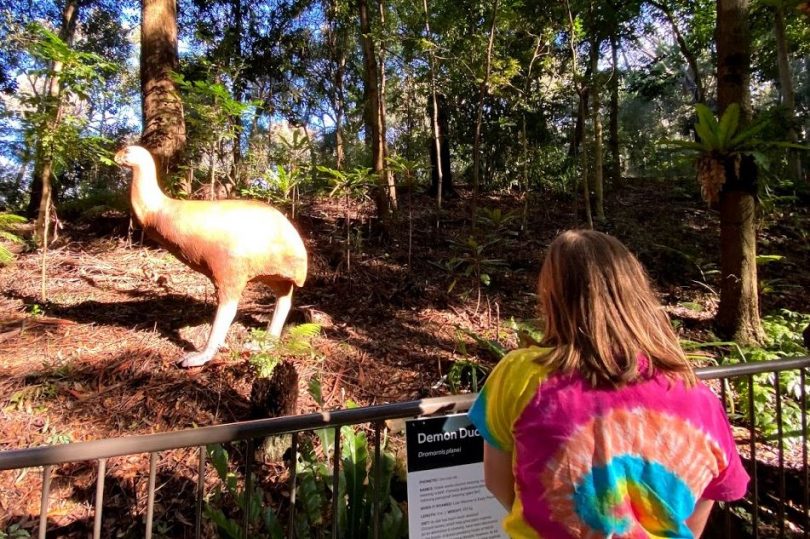
The demon duck of doom is a popular exhibit on the megafauna trail at the Australian National Botanic Gardens. Photo: Cass Proudfoot.
Giant creatures have invaded the Australian National Botanic Gardens in Canberra, and kids are loving it.
The latest adventure trail at the Botanic Gardens winds past weird and wonderful creatures from Australia’s Pleistocene past.
Two million years ago, megafauna such as giant wombats, three-metre emus and seven-metre lizards roamed the land. Replicas of some of these creatures can be seen lurking just off the path at the Botanic Gardens, where there’s a platypus hiding in the reeds, a giant horned turtle on a rock and a marsupial lion in the undergrowth.
Animals of this size don’t have much to fear so some of the megafauna creatures are standing in plain sight on the Eucalypt lawns. One is a strange short-faced kangaroo with long feet and only one long toe.
“That kangaroo didn’t hop, it actually walked,” says Megan Donaldson from the Botanic Gardens visitor services.
Shuffling on two huge feet seems an unlikely way for a kangaroo to move around, but scientists are sure about it.
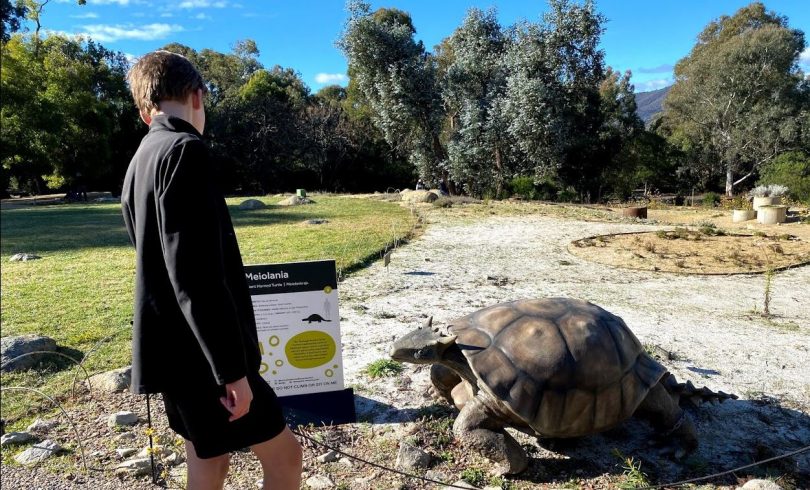
The giant horned turtle, or meiolania, was protected by horns and spikes. Photo: Cass Proudfoot.
“They can tell from the skeletons so it’s a really interesting field of work,” says Megan.
This curious kangaroo replica is positioned just under a branch of tempting gum leaves.
A few months ago, Megan wandered the gardens to find the perfect place for each of the 16 animal exhibits.
“I worked with the visitor experience team, the rangers and the horticulture teams to make sure we weren’t too close to garden beds and things,” she says.
There are maps of the megafauna trail at the visitor centre, and also in little boxes along the trail.
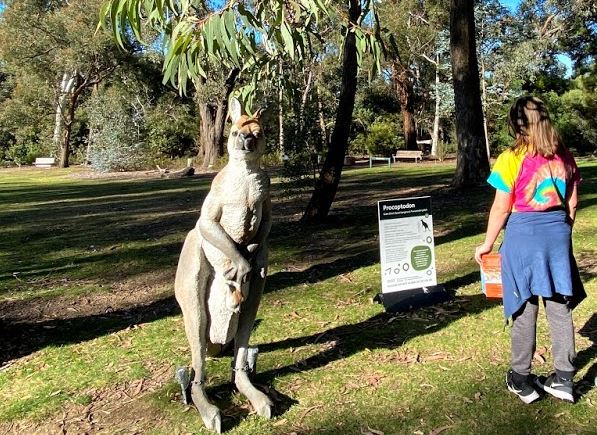
The giant short-faced kangaroo, or procoptodon goliah, had forward-facing eyes like a human. Photo: Cass Proudfoot.
Ready just in time for current school holidays, the megafauna trail has been a hit so far.
“We’ve had a steady crowd through,” says Megan. “It’s really important in these COVID-19 times to be outside, and this is a way to get the kids outside. It’s educational and they can get around for a walk.”
Younger visitors run from one creature to the next, with the Demon Duck of Doom a crowd favourite. This extinct flightless bird, Dromornis planei, looks like an overweight emu with an enormous skull and a deep curved beak to crush giant seed pods or bones.
Dispersing seed pods saw megafauna contribute to plant growth in their era – between modern times and the days of the dinosaurs.
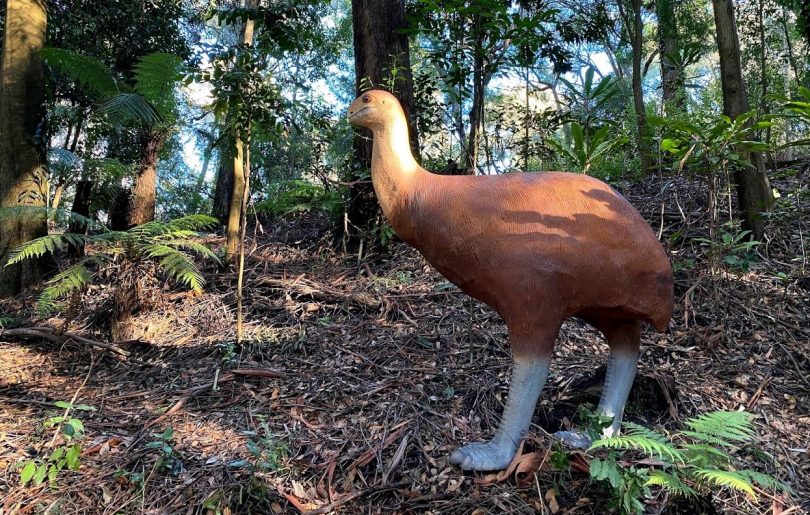
The demon duck of doom, or dromornis planei, exhibit on the megafauna trail at Australian National Botanic Gardens. Photo: Cass Proudfoot.
Some plants survive from that time, but they need a bit of extra help from horticulturalists now there are no oversize ducks and wombats to move their seeds around. There are a few of these prehistoric plants in the Botanic Gardens collection, such as the Wollemi pine, which can also be found along the megafauna trail.
One ancient creature is a surprise. The cassowary, still found in northern rainforests, is one of our most interesting surviving species of megafauna. With giant, claw-like feet and drooping skin, it is often called the dinosaur bird.
There is plenty to learn by following the map along the megafauna trail.
“It’s a one-way trail,” says Megan. “We have the trail map and information signs along the way. It’s the first time we’ve had them so if people just come across one creature they can learn something even if they’re not using the map.”
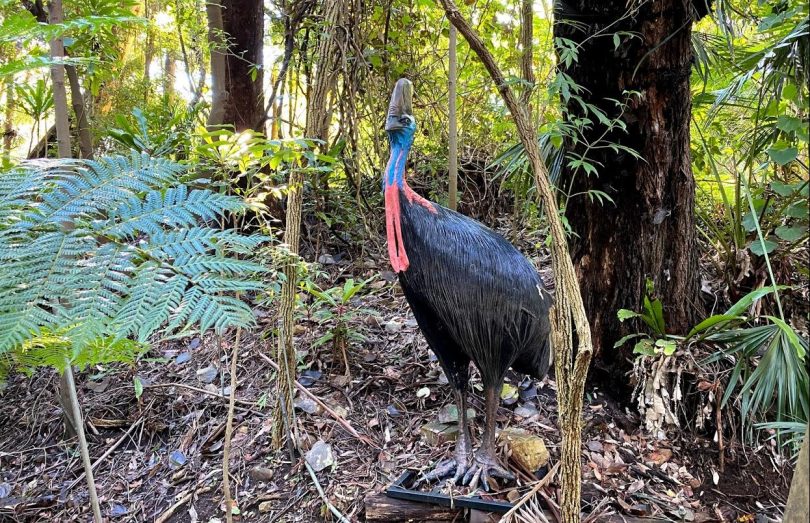
The cassowary is a living example of Australian megafauna, although this is just a replica at the Australian National Botanic Gardens. Photo: Cass Proudfoot.
The Botanic Gardens is a good home for these mysterious megafauna replicas, and with a combination of science, history and animals, the trail is a winner.
If you’re in search of a school holiday outing, grab a map and head on up the trail – last one to the top is a shuffling kangaroo!
The Adventure trail: Megafauna: Once There Were Giants! runs until Sunday, 25 July, 2021. Follow the trail through the Australian National Botanic Gardens.
Free guided walks: Ancient Plants and Animals runs from Monday, 12 July, until Sunday, 18 July, from 11:00 am to 12:00 pm, and 2:00 pm to 3:00 pm daily. On these walks you can find out what the vegetation was like in the ages of dinosaurs and megafauna.
The Australian National Botanic Gardens is open from 8:30 am to 5:00 pm daily.













